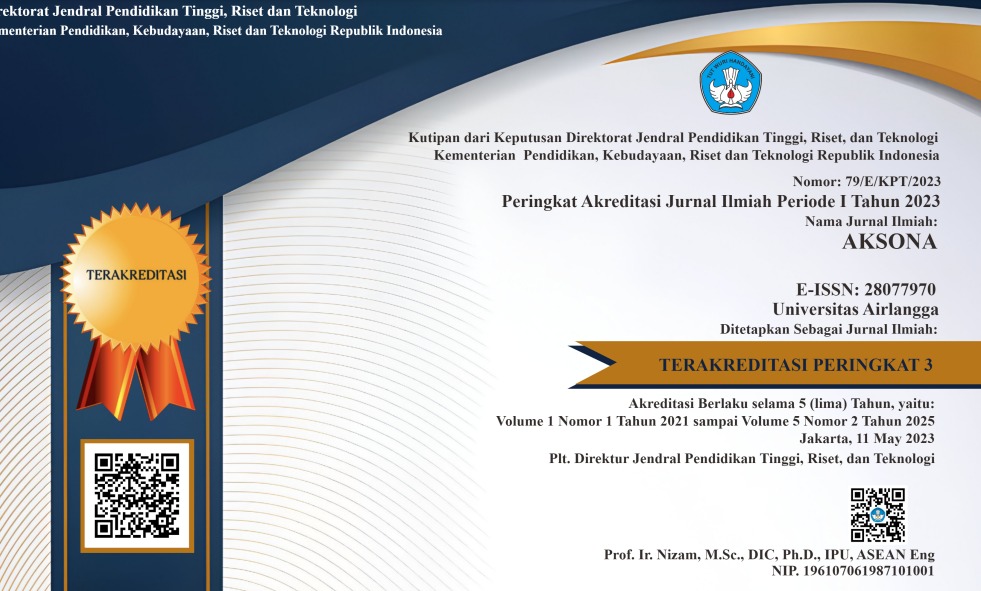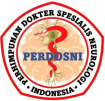Epidemiological Study of Stroke Disease in the Southeast Maluku Islands Region in 2023
Downloads
Highlight:
- The prevalence of stroke in Southeast Maluku is 14.1 per 1,000 population for 2023.
- Ischemic stroke is the most common type of stroke in the Southeast Maluku Islands.
- The most prevalent chronic disease among stroke patients in Southeast Maluku Islands is hypertension.
ABSTRACT
Introduction: Stroke is a serious health problem with a high mortality rate and incidence, especially in low- and middle-income regions like Southeast Maluku, Indonesia. Inadequate facilities and risk factors causing high stroke rates in this region provide major healthcare challenges. Epidemiological data highlight the pressing need for healthcare development. Objective: This epidemiological study aimed to provide insight on the prevalence of stroke in the Southeast Maluku Islands in 2023, with the goal of enhancing the urgency of measures to reduce stroke incidences there. Methods: This study used a descriptive methodology with a cross-sectional design. Data were collected by obtaining thorough medical records from stroke patients at Karel Sadsuitubun Regional General Hospital. Demographic information, stroke type, and comorbidities were analyzed, as well as the prevalence rate calculated from the entire patient population of 8,436 as reported in 2023, while also classifying patients by age and gender. Results: In the Southeast Maluku Islands, 107 stroke cases were reported, equal to a stroke prevalence rate of 12.6 per 1,000 people. The most common type was ischemic stroke (95.33%), followed by hemorrhagic stroke (4.67%). Hypertension, which affected 67.2% of patients, was the most common comorbidity, followed by type II diabetes mellitus and coronary artery disease. Conclusion:Stroke rates have increased in the Southeast Maluku Islands due to a variety of factors, including socioeconomic conditions and unhealthy lifestyles. The study’s findings emphasize the urgent need for interventions to reduce stroke rates.
Vahdati SS. Factors affecting complications and mortality of stroke patients in stroke care unit. Erciyes Med J. 2022; 44(2):138–42. doi: 10.14744/etd.2021.71430
Widiani GAR, Yasa IMM. Korelasi tingkat pengetahuan terhadap kemampuan deteksi dini gejala stroke dengan sikap keluarga terhadap penanganan pre hospital. Bina Gener J Kesehat. 2023; 14(2):25–30. doi: 10.35907/bgjk.v14i2.255
Feigin VL, Stark BA, Johnson CO, Roth GA, Bisignano C, Abady GG, et al. Global, regional, and national burden of stroke and its risk factors, 1990–2019: A systematic analysis for the Global Burden of Disease Study 2019. Lancet Neurol. 2021; 20(10):795–820. doi: 10.1016/S1474-4422(21)00252-0
Pu L, Wang L, Zhang R, Zhao T, Jiang Y, Han L. Projected global trends in ischemic stroke incidence, deaths and disability-adjusted life years from 2020 to 2030. Stroke. 2023; 54(5):1330–9. doi: 10.1161/STROKEAHA.122.040073
Ojaghihaghighi S, Vahdati SS, Mikaeilpour A, Ramouz A. Comparison of neurological clinical manifestation in patients with hemorrhagic and ischemic stroke. World J Emerg Med. 2017; 8(1):34–8. doi:10.5847/wjem.j.1920-8642.2017.01.006
An SJ, Kim TJ, Yoon B-W. Epidemiology, risk factors, and clinical features of intracerebral hemorrhage: An update. J Stroke . 2017 ;19(1):3–10. doi: 10.5853/jos.2016.00864
Chen S, Zeng L, Hu Z. Progressing haemorrhagic stroke: categories, causes, mechanisms and managements. J Neurol. 2014; 261(11):2061–78. doi: 10.1007/s00415-014-7291-1
Patil S, Rossi R, Jabrah D, Doyle K. Detection, diagnosis and treatment of acute ischemic stroke: Current and future perspectives. Front Med Technol. 2022; 4. doi: 10.3389/fmedt.2022.748949
Emberson J, Lees KR, Lyden P, Blackwell L, Albers G, Bluhmki E, et al. Effect of treatment delay, age, and stroke severity on the effects of intravenous thrombolysis with alteplase for acute ischaemic stroke: A meta-analysis of individual patient data from randomised trials. Lancet. 2014; 384(9958):1929–35. doi: 10.1016/S0140-6736(14)60584-5
Herpich F, Rincon F. Management of acute ischemic stroke. Crit Care Med. 2020; 48(11):1654–63. doi: 10.1097/CCM.0000000000004597
Ali RJ, Manorenj S, Zafar R. Knowledge of stroke and the window period for thrombolytic therapy in ischemic stroke among South Indians: A hospital-based survey with educational intervention. J Neurosci Rural Pract. 2024; 15(1):111–6. doi: 10.25259/JNRP_312_2023
Yang H, Huang X, Yang C, Zhu S, Chen X, Zhang M, et al. Time window for acute stroke management: A cross-sectional study among community healthcare practitioners in primary care. Int J Gen Med. 2022; 15:4483–93. doi: 10.2147/IJGM.S361189
Rehani B, Ammanuel SG, Zhang Y, Smith W, Cooke DL, Hetts SW, et al. A new era of extended time window acute stroke interventions guided by imaging. The Neurohospitalist . 2020 ;10(1):29–37. doi: 10.1177/1941874419870701
Akbarzadeh MA, Sanaie S, Kuchaki Rafsanjani M, Hosseini M-S. Role of imaging in early diagnosis of acute ischemic stroke: A literature review. Egypt J Neurol Psychiatry Neurosurg. 2021; 57(1):175. doi: 10.1186/s41983-021-00432-y
Kikukawa L. Important factors to consider when developing rural healthcare systems: Suggestions from a Moloka’i native. Hawaii J Med Public Health. 2017; 76(3 Suppl 1):47–8. [Journal]
JDIH BPK. PERMENDAGRI Nomor 137 Tahun 2017 tentang Kode dan Data Wilayah Administrasi Pemerintahan. Indonesia; 2017. [Web page]
Badan Penelitian dan Pengembangan Kesehatan. Laporan Provinsi Maluku Riskesdas 2018. Jakarta; 2019. [Web page]
Badan Pusat Statistik Provinsi Maluku. Presentase penduduk miskin menurut kabupaten/kota di Provinsi Maluku (persen), 2023-2024. Badan Pusat Statistik. 2024. [Web page]
Badan Pusat Statistik. Presentase penduduk berumur 15 tahun ke atas yang merokok tembakau selama sebulan terakhir menurut provinsi (persen), 2024. Badan Pusat Statistik(BPS - Statistics Indonesia). 2024. [Web page]
Effendi DE, Ardani I, Handayani S, Agustiya RI, Nugroho AP, Oktriyanto O, et al. Factors associated with quitting smoking among males: Findings from Indonesian national health survey. Clin Epidemiol Glob Heal. 2024; 28:101672. doi: 10.1016/j.cegh.2024.101672
Badan Penelitian dan Pengembangan Kesehatan. Laporan Riskesdas Nasional 2007. Jakarta; 2007. [Web page]
Badan Penelitian dan Pengembangan Kesehatan. Laporan Nasional Riskesdas 2018. Jakarta; 2019. [Web page]
Howard G, Kleindorfer DO, Cushman M, Long DL, Jasne A, Judd SE, et al. Contributors to the excess stroke mortality in rural areas in the United States. Stroke. 2017; 48(7):1773–8. doi: 10.1161/STROKEAHA.117.017089
McMaughan DJ, Oloruntoba O, Smith ML. Socioeconomic status and access to heatlhcare: Interrelated drivers for healthy aging. Front Public Heal. 2020; 8. doi: 10.3389/fpubh.2020.00231
Istiana M, Yeni Y. The Effect of psychosocial stress on the incidence of hypertension in rural and urban communities. Media Kesehat Masy Indones. 2019;15(4):408–17. doi: 10.30597/mkmi.v15i4.7988
Mukaz DK, Dawson E, Howard VJ, Cushman M, Higginbotham JC, Judd SE, et al. Rural/urban differences in the prevalence of stroke risk factors: A cross‐sectional analysis from the REGARDS study. J Rural Heal. 2022; 38(3):668–73. doi: 10.1111/jrh.12608
Talarima B. Faktor risiko kejadian hipertensi pada pasien di ruangan penyakit dalam RSUD Dr. M. Haulussy Ambon. Glob Heal Sci. 2016;1(2):66–74. [Journal]
Suhardi. Preferensi peminum alkohol di Indonesia menurut RISKESDAS 2007. Bul Penelit Kesehat. 2011;39(4):154–64. [Journal]
Adewole S, Mary BF. The phytochemical, proximate and mineral contents of cassava leaves and nutritive values of associated arthropod pests. J Turkish Chem Soc Sect A Chem. 2020; 7(3):675–90. doi:10.18596/jotcsa.733516
Widiarsih A, Susanna D, Eryando T. Consumption of salted fish containing high level of Natrium Chloride (NaCl) with hypertension incidence among people in area of salted fish industry. Int J Trop Med. 2017; 12(1):6–14. [Journal]
Leksono TP, Hidayat ARP, Silvano F, Lazuardi L. Risk Factors of non-communicable diseases in a frontier, outermost, and least developed (3T) archipelagic region of Indonesia: A community study. Gunadi, Yamada T, Pramana AAC, Ophinni Y, Gusnanto A, Kusuma WA, et al., editors. BIO Web Conf. 2021; 41:1–6. doi:10.1051/bioconf/20214103003
Pandian JD, Padma Srivastava MV, Aaron S, Ranawaka UK, Venketasubramanian N, Sebastian IA, et al. The burden, risk factors and unique etiologies of stroke in South-East Asia Region (SEAR). Lancet Reg Heal - Southeast Asia. 2023; 17:100290. doi:10.1016/j.lansea.2023.100290
The GBD 2016 Lifetime Risk of Stroke Collaborators. Global, regional, and country-specific lifetime risks of stroke, 1990 and 2016. N Engl J Med. 2018; 379(25):2429–37. doi:10.1056/NEJMoa1804492
Rehman S, Sahle BW, Chandra R V., Dwyer M, Thrift AG, Callisaya M, et al. Sex differences in risk factors for aneurysmal subarachnoid haemorrhage: Systematic review and meta-analysis. J Neurol Sci. 2019; 406:116446. doi:10.1016/j.jns.2019.116446
Vyas M V., Silver FL, Austin PC, Yu AYX, Pequeno P, Fang J, et al. Stroke incidence by sex across the lifespan. Stroke. 2021;52(2):447–51. doi:10.1161/STROKEAHA.120.032898
Hwong WY, Bots ML, Selvarajah S, Sivasampu S, Reidpath DD, Law WC, et al. Sex differences in stroke metrics among Southeast Asian countries: Results from the Global Burden of Disease Study 2015. Int J Stroke. 2019; 14(8):826–34. doi: 10.1177/1747493019832995
Markidan J, Cole JW, Cronin CA, Merino JG, Phipps MS, Wozniak MA, et al. Smoking and risk of ischemic stroke in young men. Stroke. 2018; 49(5):1276–8. doi:10.1161/STROKEAHA.117.018859
Boehme AK, Esenwa C, Elkind MSV. Stroke risk factors, genetics, and prevention. Circ Res. 2017; 120(3):472–95. doi:10.1161/CIRCRESAHA.116.308398
Simmons CA, Poupore N, Nathaniel TI. Age stratification and stroke severity in the telestroke network. J Clin Med. 2023;12(4):1519. doi:10.3390/jcm12041519
Li A, Ji Y, Zhu S, Hu Z, Xu X, Wang Y, et al. Risk probability and influencing factors of stroke in followed-up hypertension patients. BMC Cardiovasc Disord. 2022; 22(1):328. doi:10.1186/s12872-022-02780-w
Turana Y, Tengkawan J, Chia YC, Nathaniel M, Wang J, Sukonthasarn A, et al. Hypertension and stroke in Asia: A comprehensive review from HOPE Asia. J Clin Hypertens. 2021;23(3):513–21. doi:10.1111/jch.14099
Gao J, Dai Y, Xie Y, Zheng J, Wang Y, Guo R, et al. The association of stage 1 hypertension defined by the 2017 ACC/AHA guideline with stroke and its subtypes among elderly chinese. Demarin V, editor. Biomed Res Int. 2020; 2020(1). doi:10.1155/2020/4023787
Sacco RL, Benjamin EJ, Broderick JP, Dyken M, Easton JD, Feinberg WM, et al. Risk factors. Stroke. 1997; 28(7):1507–17. doi:10.1161/01.str.28.7.1507
Lau L, Lew J, Borschmann K, Thijs V, Ekinci EI. Prevalence of diabetes and its effects on stroke outcomes: A meta‐analysis and literature review. J Diabetes Investig. 2019; 10(3):780–92. doi:10.1111/jdi.12932
Zhang L, Li X, Wolfe CDA, O’Connell MDL, Wang Y. Diabetes as an independent risk factor for stroke recurrence in ischemic stroke patients: An update meta-analysis. Neuroepidemiology. 2021; 55(6):427–35. doi:10.1159/000519327
Arboix A. Cardiovascular risk factors for acute stroke: Risk profiles in the different subtypes of ischemic stroke. World J Clin Cases. 2015; 3(5):418–29. doi:10.12998/wjcc.v3.i5.418
Frerich S, Malik R, Georgakis MK, Sinner MF, Kittner SJ, Mitchell BD, et al. Cardiac risk factors for stroke: A comprehensive mendelian randomization study. Stroke. 2022; 53(4). doi:10.1161/STROKEAHA.121.036306
Copyright (c) 2025 Febryn Prisiliya Paliyama, Fransiskus Xaverius Rinaldi, Parningotan Yosi Silalahi, Janti Pare Nari

This work is licensed under a Creative Commons Attribution-ShareAlike 4.0 International License.





















